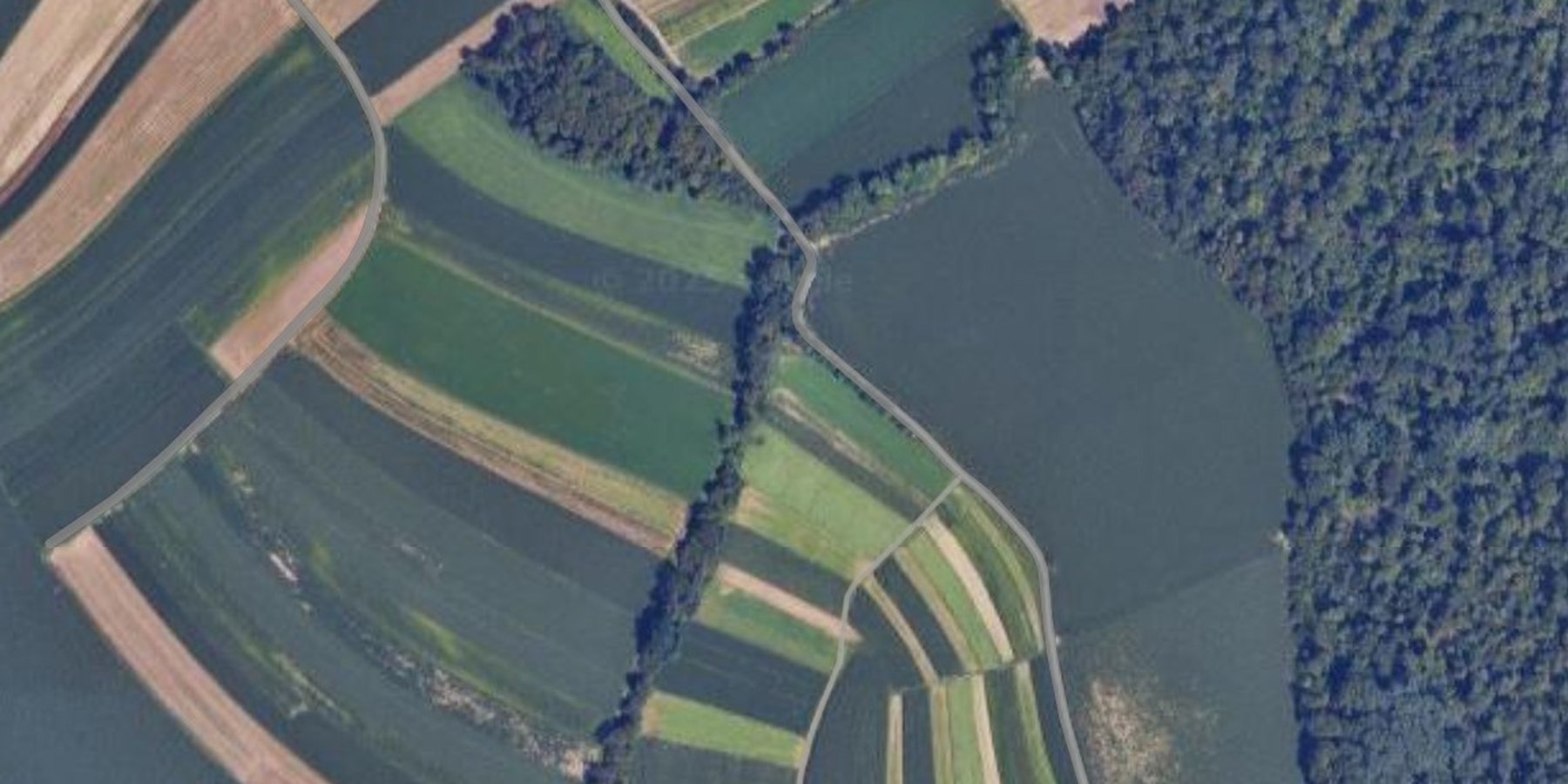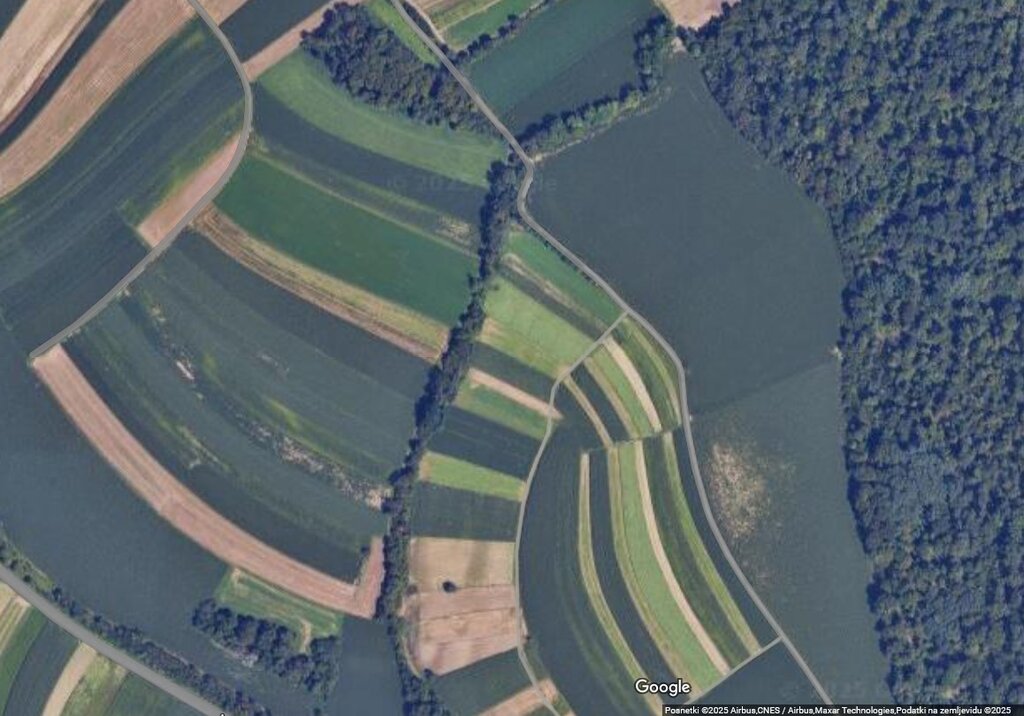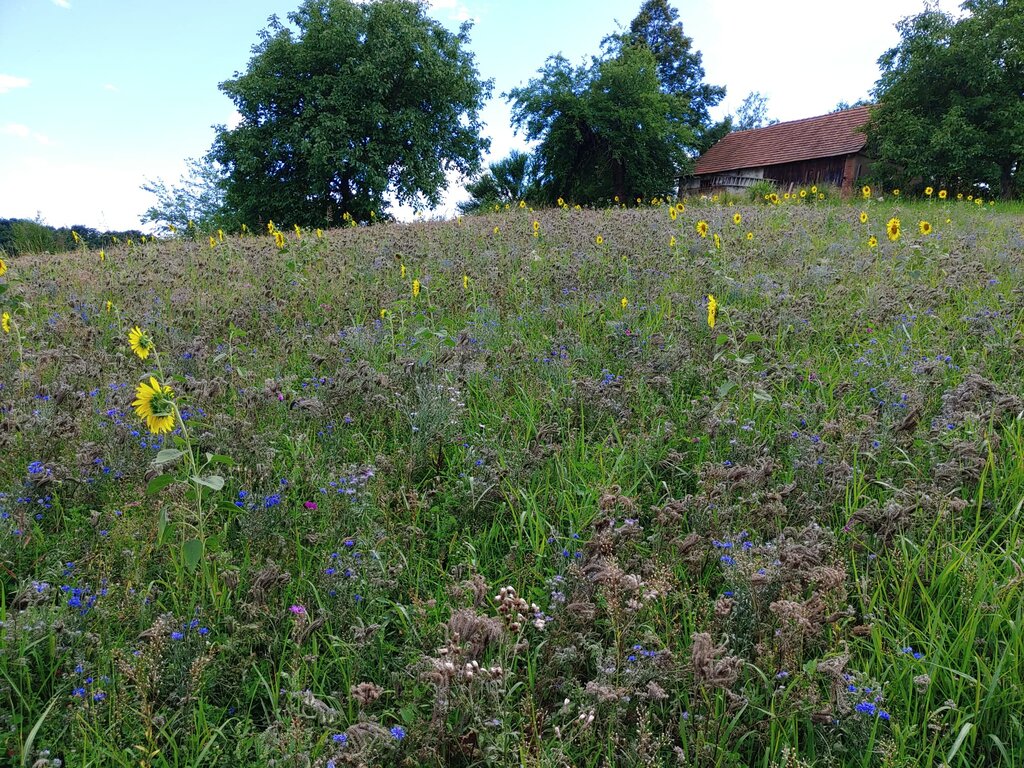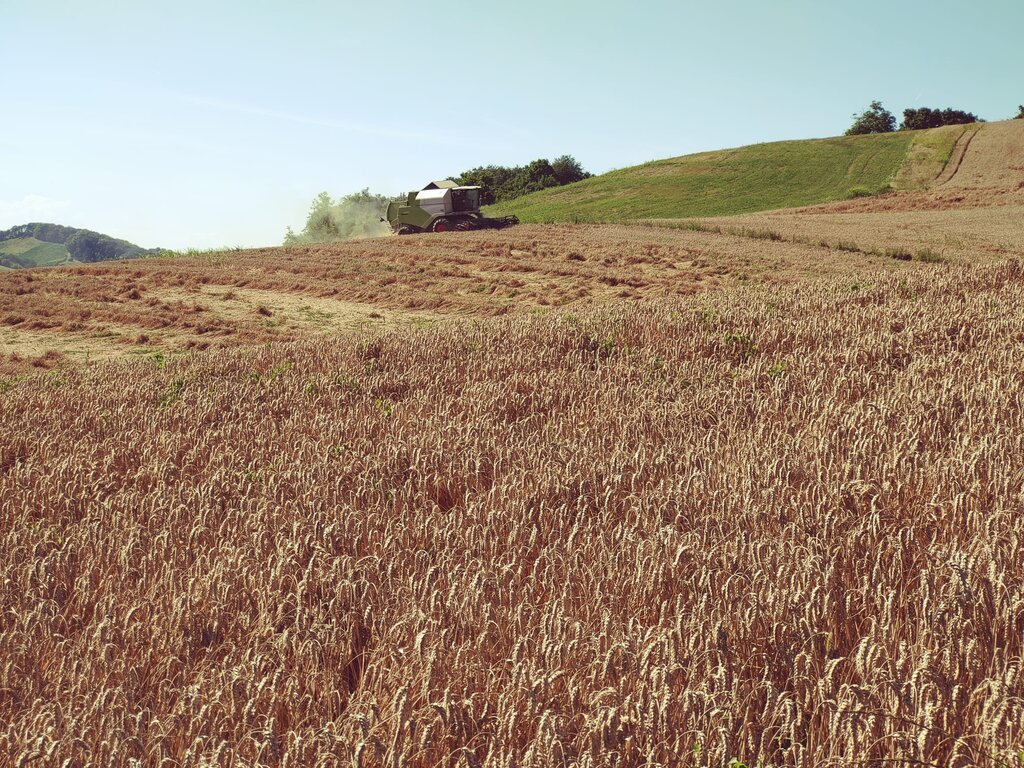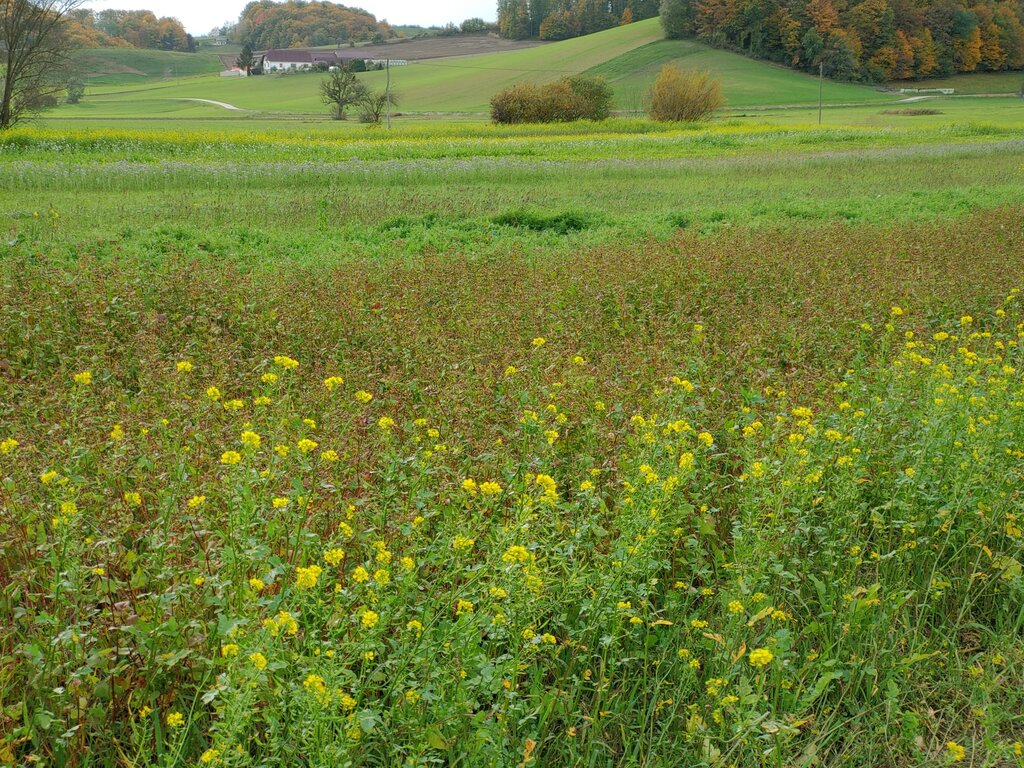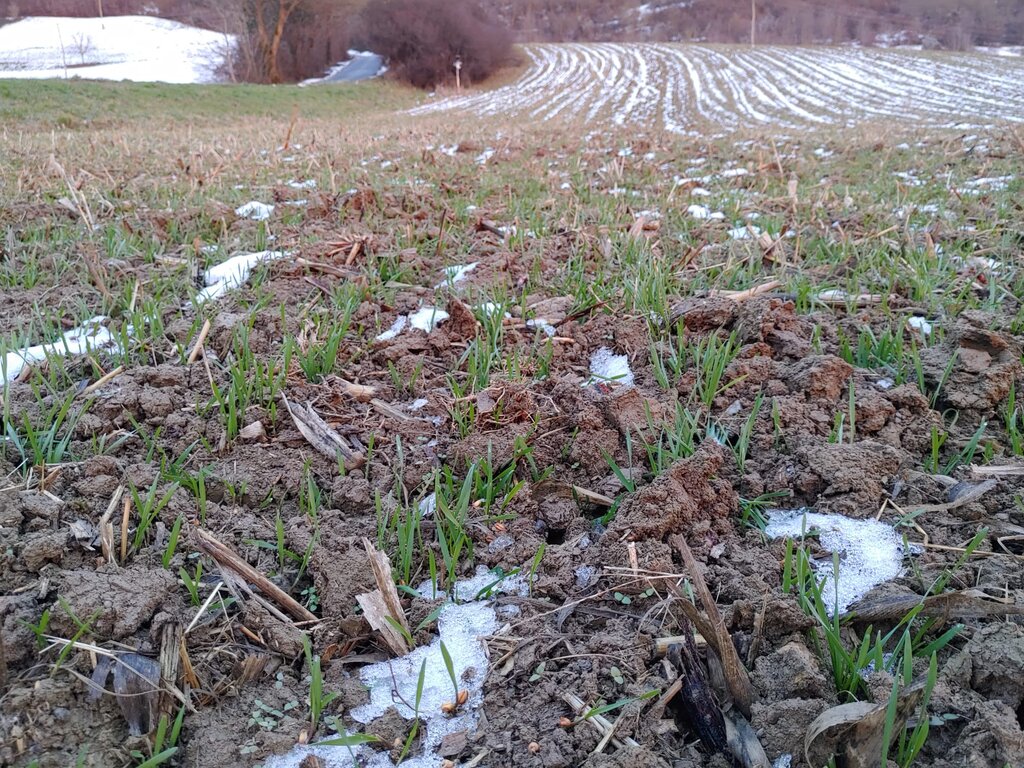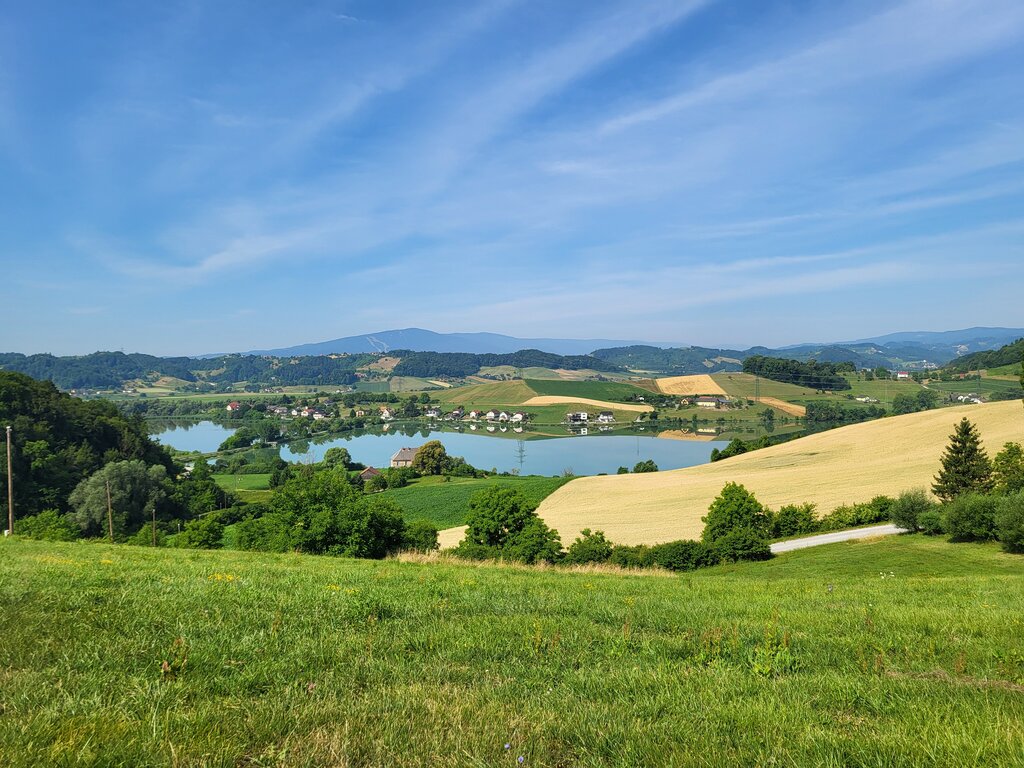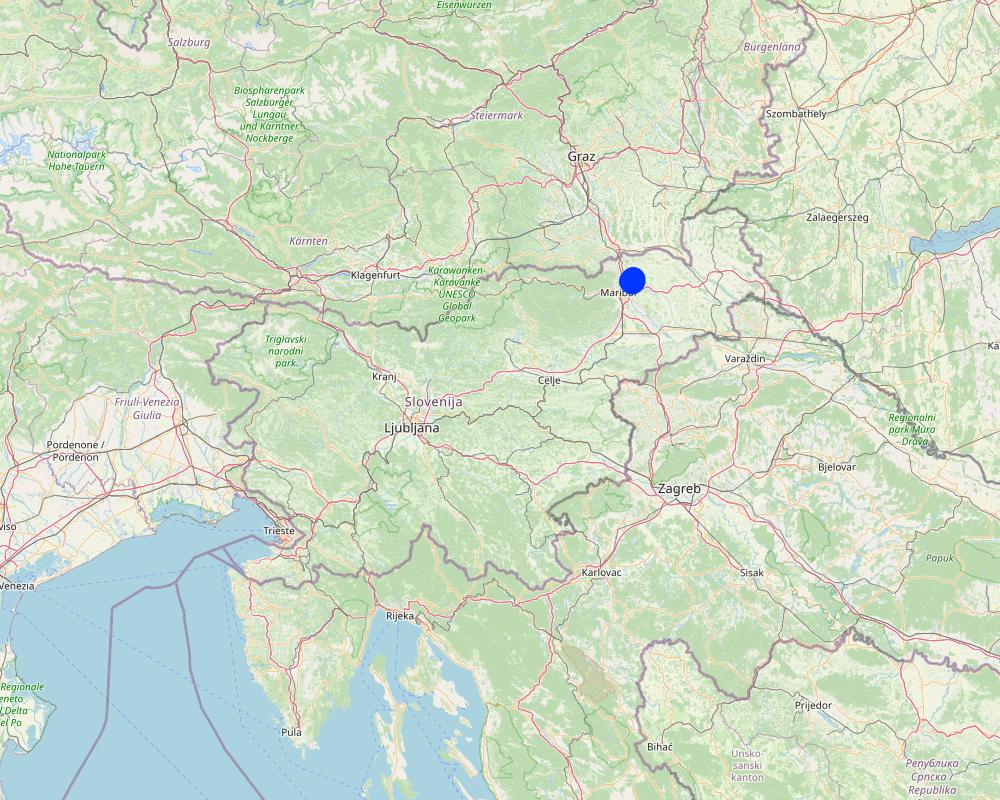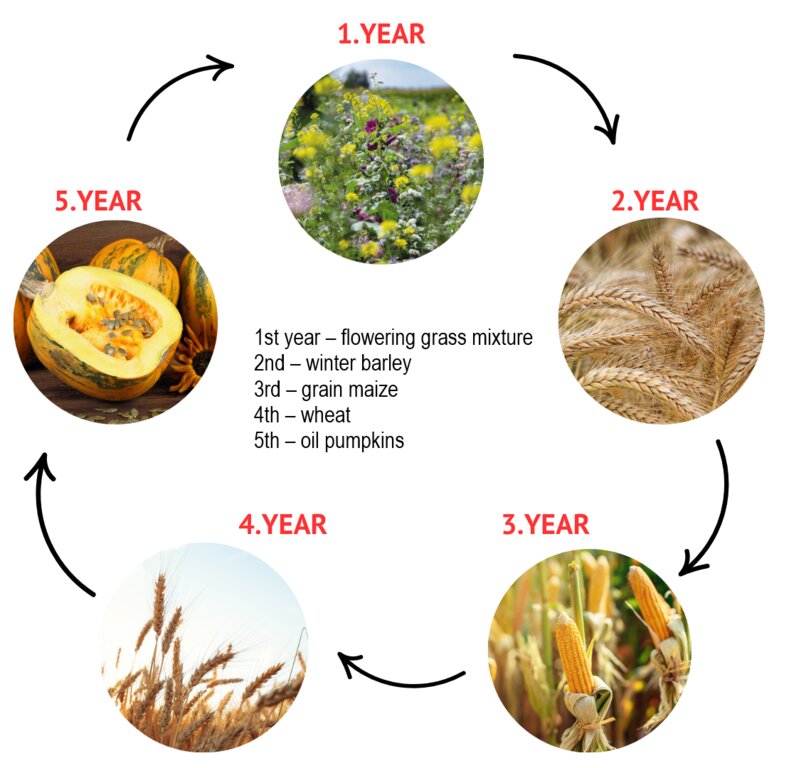5-Year Crop Rotation [Slovenia]
- Creation:
- Update:
- Compiler: Gregor Kramberger
- Editor: Tamara Korošec
- Reviewers: Rima Mekdaschi Studer, William Critchley
5-letni kolobar
technologies_6239 - Slovenia
View sections
Expand all Collapse all1. General information
1.2 Contact details of resource persons and institutions involved in the assessment and documentation of the Technology
SLM specialist:
co-compiler:
Horvat Timotej
Chamber of Agriculture and Forestry of Slovenia (KGZS) – Institute of Agriculture and Forestry Maribor
Slovenia
co-compiler:
Viltužnik Martina
Chamber of Agriculture and Forestry of Slovenia (KGZS) – Institute of Agriculture and Forestry Maribor
Slovenia
land user:
Ropič Andrej
Farmer
Slovenia
SLM specialist:
Kep Tina
Chamber of Agriculture and Forestry of Slovenia (KGZS) – Institute of Agriculture and Forestry Maribor
Slovenia
Name of project which facilitated the documentation/ evaluation of the Technology (if relevant)
OPtimal strategies to retAIN and re-use water and nutrients in small agricultural catchments across different soil-climatic regions in Europe (OPTAIN)Name of the institution(s) which facilitated the documentation/ evaluation of the Technology (if relevant)
Chamber of Agriculture and Forestry of Slovenia – Institute of Agriculture and Forestry Maribor (KGZS) - Slovenia1.3 Conditions regarding the use of data documented through WOCAT
The compiler and key resource person(s) accept the conditions regarding the use of data documented through WOCAT:
Yes
1.4 Declaration on sustainability of the described Technology
Is the Technology described here problematic with regard to land degradation, so that it cannot be declared a sustainable land management technology?
No
2. Description of the SLM Technology
2.1 Short description of the Technology
Definition of the Technology:
Crop rotation is good practice in agricultural production. It comprises alternating different types of crops, usually in a specific order. Crop rotation maintains soil fertility, reduces the risk of diseases and pests, and optimizes nutrient utilization. In Slovenia, a 5-year rotation is proving especially effective.
2.2 Detailed description of the Technology
Description:
Crop rotation is a system of alternating arable crops, forage plants, aromatic herbs, and vegetables, generally in a specific sequence. It can be applied in fields, gardens, or enclosed growing spaces. Crop rotation is adaptable and can be used under different farming systems, such as organic, integrated, and conventional farming. It maximises the efficiency of biological, organizational, and spatial influences on soil and plants. The fundamental element of crop rotation is the selection of plant species that are most effectively alternated on the same piece of land over different years. To ensure the best selection, it is essential to understand the farming technology, the type and structure of the soil, and its nutrient composition.
By implementing good crop rotation, nutrient utilization is optimized, and the risk of diseases and pests is reduced. Crop rotation also ensures the sustainable use of soil by improving its structure and fertility. The inclusion of cover crops in a rotation helps to maintain continuous soil cover. Crop rotation also facilitates better adaptation to climate change (drought, hail, floods etc), depending on the plants included in the rotation. The inclusion of green manure crops and the use of organic fertilizers can reinforce crop rotation and further support soil fertility enhancement and conservation.
To establish and maintain crop rotation, a detailed plan must be prepared, including the selection of crops based on soil characteristics, nutrient requirements, and crop sequencing needs. A fertilization plan should also be developed in parallel. It is crucial to ensure appropriate agricultural machinery, especially for specialty crops, and to have sufficient labour available, as more complex rotations may increase workload. Additionally, market research for new crops and demand assessment should be conducted.
In summary, crop rotation offers numerous benefits:
- Enhances soil fertility and improves soil structure.
- Reduces diseases, pests, and weeds.
- Minimises nutrient leaching and soil erosion.
- Increases organic matter content in the soil.
- Boosts biodiversity and strengthens soil resilience to weather changes.
- Enables efficient resource utilization and reduces production costs.
Thus, crop rotation offers numerous benefits that farmers appreciate – all of which help ensure higher and more sustainable yields. However, this technology requires specific knowledge, precise planning, and careful scheduling, which increases the complexity of production. It also demands more labour and sometimes additional machinery, leading to higher production costs. Furthermore, marketing various crops requires careful consideration, which can pose a challenge for farmers.
Crop rotation in Slovenia is supported by Agri-Environmental-Climate Payments (CAP), which enables farmers to receive funding for implementing a diverse and effective crop rotation system.
An effective 5-year rotation system in Slovenia typically follows the following sequence:
1st year – flowering grass mixture
2nd – winter barley
3rd – grain maize
4th – wheat
5th – oil pumpkins
This ensures that at least three different annual crops are grown within the five years, while integrating legumes like alfalfa or red clover every 3–4 years to enrich soil nitrogen levels. Cereals may appear up to three times in the rotation, but never in consecutive years. After cereal crops the farmer may alternatively sow non-winter-hardy honey-producing cover crops. Despite this structured guidance, many rotations in Slovenia remain too narrow. National laws and guidelines for agri-environmental measures support farmers in designing good crop sequences.
2.3 Photos of the Technology
2.5 Country/ region/ locations where the Technology has been applied and which are covered by this assessment
Country:
Slovenia
Region/ State/ Province:
Jareninski dol, Pernica
Further specification of location:
Vosek
Specify the spread of the Technology:
- evenly spread over an area
If the Technology is evenly spread over an area, specify area covered (in km2):
137.0
Is/are the technology site(s) located in a permanently protected area?
No
Comments:
In the case study area of Pesnica, OPTAIN project.
Map
×2.6 Date of implementation
If precise year is not known, indicate approximate date:
- less than 10 years ago (recently)
2.7 Introduction of the Technology
Specify how the Technology was introduced:
- through land users' innovation
- during experiments/ research
Comments (type of project, etc.):
Over the years, the farmer has experimented with different farming methods and discovered the benefits of crop rotation. His rotation plan is tailored to the farm’s needs, specific production requirements related to on-farm animal husbandry, and market opportunities. He is one of several farmers in the area practicing crop rotation, which is also supported and encouraged through CAP subsidies.
3. Classification of the SLM Technology
3.1 Main purpose(s) of the Technology
- improve production
- reduce, prevent, restore land degradation
- conserve ecosystem
- preserve/ improve biodiversity
- create beneficial economic impact
3.2 Current land use type(s) where the Technology is applied
Land use mixed within the same land unit:
No
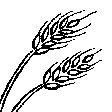
Cropland
- Annual cropping
Annual cropping - Specify crops:
- cereals - barley
- cereals - maize
- cereals - wheat (winter)
- flower crops
- oilseed crops - sunflower, rapeseed, other
Number of growing seasons per year:
- 1
Is intercropping practiced?
No
Is crop rotation practiced?
Yes
If yes, specify:
The technology is based on a 5-year crop rotation, which includes the following crops:
1st year: flowering grass mixture,
2nd year: winter barley,
3rd year: grain maize,
4th year: wheat,
5th year: oil pumpkins.
3.3 Has land use changed due to the implementation of the Technology?
Has land use changed due to the implementation of the Technology?
- No (Continue with question 3.4)
3.4 Water supply
Water supply for the land on which the Technology is applied:
- rainfed
3.5 SLM group to which the Technology belongs
- rotational systems (crop rotation, fallows, shifting cultivation)
3.6 SLM measures comprising the Technology
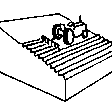
agronomic measures
- A1: Vegetation/ soil cover
- A2: Organic matter/ soil fertility
3.7 Main types of land degradation addressed by the Technology
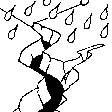
soil erosion by water
- Wt: loss of topsoil/ surface erosion
- Wg: gully erosion/ gullying

soil erosion by wind
- Et: loss of topsoil
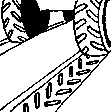
physical soil deterioration
- Pc: compaction
- Pk: slaking and crusting
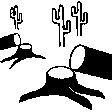
biological degradation
- Bc: reduction of vegetation cover
- Bh: loss of habitats
- Bq: quantity/ biomass decline
- Bs: quality and species composition/ diversity decline
- Bp: increase of pests/ diseases, loss of predators

water degradation
- Hp: decline of surface water quality
- Hq: decline of groundwater quality
3.8 Prevention, reduction, or restoration of land degradation
Specify the goal of the Technology with regard to land degradation:
- prevent land degradation
- reduce land degradation
4. Technical specifications, implementation activities, inputs, and costs
4.1 Technical drawing of the Technology
Technical specifications (related to technical drawing):
Crop sequencing: At least three different types of annual crops must be included within a five-year period.
Time intervals: Leguminous plants such as alfalfa or red clover must be incorporated every 3–4 years. In the case of maize, it can be included in the rotation a maximum of three times within five years, but never consecutively. Similarly, cereals can be included a maximum of three times in the five-year rotation.
Cover Crops: Mandatory in areas prone to erosion and where maize constitutes more than 50% of the rotation. Do not count as one of the three different agricultural crops that must be included in the five-year rotation.
Author:
Martina Viltužnik
Date:
21/02/2025
4.2 General information regarding the calculation of inputs and costs
Specify how costs and inputs were calculated:
- per Technology area
Indicate size and area unit:
28.6 hectares
If using a local area unit, indicate conversion factor to one hectare (e.g. 1 ha = 2.47 acres): 1 ha =:
1 ha = 10.000 m2
other/ national currency (specify):
EUR
If relevant, indicate exchange rate from USD to local currency (e.g. 1 USD = 79.9 Brazilian Real): 1 USD =:
0.85
Indicate average wage cost of hired labour per day:
114
4.3 Establishment activities
| Activity | Timing (season) | |
|---|---|---|
| 1. | Purchase of a roller | 1st year |
Comments:
At the beginning, the farm is assumed to be equipped with standard agricultural machinery. However, to expand the crop rotation to a 5-year system, additional specialized equipment is usually required for cultivating new crops. Such machinery is later typically used for around 20 years or more, although the standard depreciation period for such equipment is approximately 12 years. This is only an estimated time frame, as actual usage may vary. Farmers generally continue using the roller as long as it remains functional and economically viable. Depreciation was not included in the cost calculation, as it is generally accounted for at the whole-farm level rather than per individual measure/crop production.
4.4 Costs and inputs needed for establishment
| Specify input | Unit | Quantity | Costs per Unit | Total costs per input | % of costs borne by land users | |
|---|---|---|---|---|---|---|
| Equipment | Roller | piece | 1.0 | 6100.0 | 6100.0 | 70.0 |
| Total costs for establishment of the Technology | 6100.0 | |||||
| Total costs for establishment of the Technology in USD | 7176.47 | |||||
If land user bore less than 100% of costs, indicate who covered the remaining costs:
Part of the agricultural machinery intended for the implementation of environmental measures can be funded through non-repayable grants from European and national funds under the CAP.
4.5 Maintenance/ recurrent activities
| Activity | Timing/ frequency | |
|---|---|---|
| 1. | Total variable costs of grain maize production | Once a year |
| 2. | Total variable costs of barley production | Once a year |
| 3. | Total variable costs of wheat production | Once a year |
| 4. | Total variable costs of oil pumpkin production | Once a year |
| 5. | Total variable costs of flowering grass mixture production | Once a year |
Comments:
Variable costs represent the total production costs for each specific crop, including seeds, plant nutrients, plant protection products, other material costs, variable machinery and labor costs, insurance, and financing costs.
4.6 Costs and inputs needed for maintenance/ recurrent activities (per year)
| Specify input | Unit | Quantity | Costs per Unit | Total costs per input | % of costs borne by land users | |
|---|---|---|---|---|---|---|
| Other | Variable costs of grain maize production | ha | 5.72 | 1518.0 | 8682.96 | 100.0 |
| Other | Variable costs of barley production | ha | 5.72 | 1112.0 | 6360.64 | 100.0 |
| Other | Variable costs of wheat production | ha | 5.72 | 1354.0 | 7744.88 | 100.0 |
| Other | Variable costs of oil pumpkin production | ha | 5.72 | 2061.0 | 11788.92 | 100.0 |
| Other | Variable costs of flowering grass mixture production | ha | 5.72 | 477.3 | 2730.16 | 100.0 |
| Total costs for maintenance of the Technology | 37307.56 | |||||
| Total costs for maintenance of the Technology in USD | 43891.25 | |||||
Comments:
The farmer cultivates a total of 28.6 hectares of arable land, theoretically divided into five equal parts under the 5-year crop rotation system. For comparison purposes only, if a simpler system with just maize, wheat, and barley were used and the 28.6 ha were equally divided into three parts (9.53 ha per crop), the total variable costs would amount to 37,967.52 €. Such an even distribution is not practiced in reality—it is used here solely to illustrate the cost comparison.
4.7 Most important factors affecting the costs
Describe the most determinate factors affecting the costs:
The total area is theoretically divided into five equal parts, following the 5-year crop rotation system. However, in practice, this division is not perfectly even. Other important cost factors include variations in input prices (such as seeds, fertilizers, and plant protection products), machinery costs, labor availability, and weather conditions that impact yields and operational efficiency.
5. Natural and human environment
5.1 Climate
Annual rainfall
- < 250 mm
- 251-500 mm
- 501-750 mm
- 751-1,000 mm
- 1,001-1,500 mm
- 1,501-2,000 mm
- 2,001-3,000 mm
- 3,001-4,000 mm
- > 4,000 mm
Specify average annual rainfall (if known), in mm:
1032.00
Specifications/ comments on rainfall:
Most precipitation falls in summer, the months with the highest average precipitation are August and September, the least precipitation falls in winter, in January and February at least, and in principle more precipitation falls in autumn than in spring.
Indicate the name of the reference meteorological station considered:
Jareninski Vrh (1991-2020)
Agro-climatic zone
- sub-humid
The average annual air temperature at Jareninski Vrh during the reference period 1991–2020 was 10.1 °C.
5.2 Topography
Slopes on average:
- flat (0-2%)
- gentle (3-5%)
- moderate (6-10%)
- rolling (11-15%)
- hilly (16-30%)
- steep (31-60%)
- very steep (>60%)
Landforms:
- plateau/plains
- ridges
- mountain slopes
- hill slopes
- footslopes
- valley floors
Altitudinal zone:
- 0-100 m a.s.l.
- 101-500 m a.s.l.
- 501-1,000 m a.s.l.
- 1,001-1,500 m a.s.l.
- 1,501-2,000 m a.s.l.
- 2,001-2,500 m a.s.l.
- 2,501-3,000 m a.s.l.
- 3,001-4,000 m a.s.l.
- > 4,000 m a.s.l.
Indicate if the Technology is specifically applied in:
- not relevant
5.3 Soils
Soil depth on average:
- very shallow (0-20 cm)
- shallow (21-50 cm)
- moderately deep (51-80 cm)
- deep (81-120 cm)
- very deep (> 120 cm)
Soil texture (topsoil):
- medium (loamy, silty)
Soil texture (> 20 cm below surface):
- medium (loamy, silty)
Topsoil organic matter:
- medium (1-3%)
5.4 Water availability and quality
Ground water table:
5-50 m
Availability of surface water:
good
Water quality (untreated):
for agricultural use only (irrigation)
Water quality refers to:
surface water
Is water salinity a problem?
No
Is flooding of the area occurring?
Yes
Regularity:
episodically
Comments and further specifications on water quality and quantity:
Hydromelioration was carried out in the area, a drainage system and water retention systems (e.g. ponds and basins) were arranged.
5.5 Biodiversity
Species diversity:
- medium
Habitat diversity:
- medium
5.6 Characteristics of land users applying the Technology
Sedentary or nomadic:
- Sedentary
Market orientation of production system:
- commercial/ market
Off-farm income:
- 10-50% of all income
Relative level of wealth:
- average
Individuals or groups:
- individual/ household
Level of mechanization:
- mechanized/ motorized
Gender:
- men
Age of land users:
- middle-aged
5.7 Average area of land used by land users applying the Technology
- < 0.5 ha
- 0.5-1 ha
- 1-2 ha
- 2-5 ha
- 5-15 ha
- 15-50 ha
- 50-100 ha
- 100-500 ha
- 500-1,000 ha
- 1,000-10,000 ha
- > 10,000 ha
Is this considered small-, medium- or large-scale (referring to local context)?
- medium-scale
5.8 Land ownership, land use rights, and water use rights
Land ownership:
- individual, titled
Land use rights:
- leased
- individual
Water use rights:
- communal (organized)
Are land use rights based on a traditional legal system?
No
Specify:
Based on national legal system.
5.9 Access to services and infrastructure
health:
- poor
- moderate
- good
education:
- poor
- moderate
- good
technical assistance:
- poor
- moderate
- good
employment (e.g. off-farm):
- poor
- moderate
- good
markets:
- poor
- moderate
- good
energy:
- poor
- moderate
- good
roads and transport:
- poor
- moderate
- good
drinking water and sanitation:
- poor
- moderate
- good
financial services:
- poor
- moderate
- good
6. Impacts and concluding statements
6.1 On-site impacts the Technology has shown
Socio-economic impacts
Production
crop production
Comments/ specify:
A diverse crop rotation helps maintain stable yields over a longer period by improving soil fertility, reducing disease pressure, and optimizing nutrient availability.
crop quality
Comments/ specify:
Reduced disease and pest pressure lead to healthier, more resilient plants, while increased natural soil fertility enhances overall crop quality.
fodder production
Comments/ specify:
The crop rotation provides an additional opportunity to grow forage crops for feed.
risk of production failure
Comments/ specify:
A diverse crop rotation enhances system resilience, reducing the risk of production failure in cases of natural disasters such as droughts or heavy rainfall and decreases the possibility of pest invasion and disease.
product diversity
Comments/ specify:
Additional crops in the rotation contribute to production diversification, reducing dependence on a single crop.
land management
Comments/ specify:
Crop rotation requires more complex land management, planning, and agronomic expertise.
Water availability and quality
drinking water quality
Comments/ specify:
Reduced use of plant protection products and synthetic fertilizers helps protect drinking water quality.
Income and costs
expenses on agricultural inputs
Comments/ specify:
Lower use of plant protection products and synthetic fertilizers reduces input costs. Some crops in the rotation have somewhat higher seed and labour costs.
diversity of income sources
Comments/ specify:
The diversity of crops leads to a more diversified income from multiple sources.
workload
Comments/ specify:
A diverse crop rotation increases workload due to more complex crop management, additional agronomic tasks, and greater administrative demands, requiring efficient planning and organization.
Socio-cultural impacts
food security/ self-sufficiency
Comments/ specify:
Some crops that currently dominate monocultures can be replaced with alternative plants, contributing to increased overall self-sufficiency.
Ecological impacts
Water cycle/ runoff
water quality
Comments/ specify:
Reduced use of plant protection products and synthetic fertilizers helps improve overall water quality. Various root systems help to better use the nitrogen and other nutrients.
Soil
nutrient cycling/ recharge
Comments/ specify:
Including nitrogen-fixing legumes in the crop rotation enhances nutrient cycling and soil recharge. Different crops have different nutrient requirements and different root systems extract nutrients from different depths.
soil organic matter/ below ground C
Comments/ specify:
Including crops with higher organic residues contributes to increased soil organic matter and carbon storage.
Biodiversity: vegetation, animals
Vegetation cover
Comments/ specify:
Flowering plants included in the rotation provide a beneficial habitat for pollinators and other insects.
biomass/ above ground C
Comments/ specify:
Increased organic residues contribute to higher above-ground biomass and carbon storage.
plant diversity
Comments/ specify:
Increased diversity of plant species in the crop rotation.
invasive alien species
Comments/ specify:
Crop rotation helps prevent the establishment of invasive species by creating less favorable conditions for their spread.
beneficial species
Comments/ specify:
The inclusion of more flowering plants supports a higher population of beneficial insects.
pest/ disease control
Comments/ specify:
A diverse crop rotation helps prevent the spread of diseases and pests.
Specify assessment of on-site impacts (measurements):
The data have not been obtained through specific measurements but rather through a questionnaire with the farmer and insights from other farms and agricultural advisors.
6.2 Off-site impacts the Technology has shown
groundwater/ river pollution
Comments/ specify:
Reduced use of plant protection products and fertilizers helps minimize groundwater and river pollution.
Specify assessment of off-site impacts (measurements):
The data have not been obtained through specific measurements but rather through a questionnaire with the farmer and insights from other farms and agricultural advisors.
6.3 Exposure and sensitivity of the Technology to gradual climate change and climate-related extremes/ disasters (as perceived by land users)
Gradual climate change
Gradual climate change
| Season | increase or decrease | How does the Technology cope with it? | |
|---|---|---|---|
| annual temperature | increase | moderately | |
| seasonal temperature | summer | increase | not well |
| seasonal temperature | spring | increase | well |
| seasonal temperature | autumn | increase | well |
| seasonal temperature | winter | increase | well |
| seasonal rainfall | summer | increase | moderately |
| seasonal rainfall | spring | increase | not well |
| seasonal rainfall | autumn | decrease | moderately |
Climate-related extremes (disasters)
Meteorological disasters
| How does the Technology cope with it? | |
|---|---|
| local rainstorm | moderately |
| local hailstorm | not well at all |
Climatological disasters
| How does the Technology cope with it? | |
|---|---|
| heatwave | moderately |
| drought | not well |
Hydrological disasters
| How does the Technology cope with it? | |
|---|---|
| general (river) flood | moderately |
Other climate-related consequences
Other climate-related consequences
| How does the Technology cope with it? | |
|---|---|
| extended growing period | well |
6.4 Cost-benefit analysis
How do the benefits compare with the establishment costs (from land users’ perspective)?
Short-term returns:
slightly negative
Long-term returns:
neutral/ balanced
How do the benefits compare with the maintenance/ recurrent costs (from land users' perspective)?
Short-term returns:
slightly negative
Long-term returns:
slightly positive
Comments:
The establishment costs are relatively high due to investments in new machinery, which can be quite expensive. As a result, the short-term return is considered slightly negative. However, when comparing benefits with these costs, the long-term advantages—such as higher product quality, reduced yield losses, environmental protection, and increased diversification—have a neutral/ balanced impact, leading to more stable and resilient production. In the short term, the comparison of benefits with maintenance and recurrent costs is slightly negative, primarily due to increased labor requirements, the need for more knowledge, and a higher risk of errors. However, as these challenges are addressed and efficiency improves, the long-term outlook is slightly positive, especially due to the potential reduction in costs over time.
6.5 Adoption of the Technology
- 1-10%
Of all those who have adopted the Technology, how many did so spontaneously, i.e. without receiving any material incentives/ payments?
- 0-10%
Comments:
Most of the farmers decide for sustainable practices because of the subsidies, but there are three main reasons why many farmers don't adopt the subsidized form of 5 years crop rotation under the agri-environmental scheme (KOPOP), despite available support:
1. One of the specific conditions of the KOPOP measure is that farmers are not allowed to reduce their arable land area over the 5-year period. Due to uncertainty—especially regarding leased land—many farmers hesitate to commit.
2. Farmers prefer to maintain flexibility in their production choices so they can respond to market demand, grow more profitable crops, or focus on crops that are easier to cultivate.
3. Many farmers prioritize lower-cost production systems that offer higher profit margins, which discourages them from choosing more diverse and potentially riskier rotations.
6.6 Adaptation
Has the Technology been modified recently to adapt to changing conditions?
Yes
If yes, indicate to which changing conditions it was adapted:
- changing markets
Specify adaptation of the Technology (design, material/ species, etc.):
The specific changes in crop rotation often involve adjustments based on market conditions, input costs, or weather-related risks. For example, a farmer may decide to stop producing soy due to lower prices or higher production risks and instead increase the area under barley, which is less input-intensive and more market-stable. Such changes are made annually, allowing farmers to remain flexible within the broader rotation framework, even if they maintain a diverse system overall.
6.7 Strengths/ advantages/ opportunities of the Technology
| Strengths/ advantages/ opportunities in the land user’s view |
|---|
| Reduced costs of pesticides and mineral fertilizer use. |
| Improved soil fertility and higher yields. |
| Reduced weed pressure. |
| Improved soil structure. |
| Strengths/ advantages/ opportunities in the compiler’s or other key resource person’s view |
|---|
| Reduction of nitrate leaching into drinking water. |
| Contribution to environmental protection and emission reduction. |
| Preservation of biodiversity. |
| Support for sustainable agricultural practices. |
6.8 Weaknesses/ disadvantages/ risks of the Technology and ways of overcoming them
| Weaknesses/ disadvantages/ risks in the land user’s view | How can they be overcome? |
|---|---|
| Need for additional knowledge. | Providing targeted training and advisory services to improve knowledge and technical skills. |
| More time required for planning and monitoring. | Using digital tools and software for more efficient planning and monitoring. |
| Monoculture is not allowed. | Emphasizing long-term benefits, such as improved soil fertility and yield stability, to outweigh the limitations of monoculture. |
| Higher labor costs. | Optimizing mechanization and labor organization to reduce workload and improve efficiency. |
| Weaknesses/ disadvantages/ risks in the compiler’s or other key resource person’s view | How can they be overcome? |
|---|---|
| Improperly implemented crop rotation can lead to the spread of pests and diseases and soil depletion. | Providing training and guidelines on proper crop rotation planning to prevent pest and disease buildup and maintain soil fertility. |
| Incorrectly collected soil samples for soil analysis, which serves as the basis for fertilizer planning, can result in inaccurate calculations for optimal fertilization and nutrient management. | Educating farmers on correct soil sampling techniques to ensure accurate soil analysis and nutrient management planning. |
| Lack of farm records and planning can make it difficult to optimize crop rotation. | Encouraging systematic record-keeping and the use of digital tools to document and optimize crop rotation strategies. |
7. References and links
7.1 Methods/ sources of information
- interviews with land users
1 (Andrej Ropič, farmer)
- interviews with SLM specialists/ experts
2 (Chamber of Agriculture and Forestry of Slovenia (KGZS) – Institute of Agriculture and Forestry Maribor; Tamara Korošec and Timotej Horvat)
- compilation from reports and other existing documentation
CAP and Slovenian Strategic Plan 2023-2027.
When were the data compiled (in the field)?
17/01/2023
Comments:
I conducted an on-site visit and interviewed the farmer.
7.2 References to available publications
Title, author, year, ISBN:
Ballot, R., Guilpart, N., and Jeuffroy, M.-H. (2023). The first map of crop sequence types in Europe over 2012–2018, Earth Syst. Sci. Data, 15, 5651–5666.
Available from where? Costs?
https://doi.org/10.5194/essd-15-5651-2023
Title, author, year, ISBN:
Nowak, B., Michaud, A., & Marliac, G. (2022). Assessment of the diversity of crop rotations based on network analysis indicators. Agricultural Systems, 199, 103402.
Available from where? Costs?
https://doi.org/10.1016/j.agsy.2022.103402
7.3 Links to relevant online information
Title/ description:
Improved Crop Rotation – Ecologic Institute (2022)
URL:
https://www.ecologic.eu/19055
Title/ description:
Ministry of Agriculture, Forestry and Food. (2024). Unified Application 2024: Guidelines for the implementation of interventions under the Strategic Plan of the Common Agricultural Policy 2023–2027. Ljubljana, Slovenia.
URL:
https://www.kgzs.si/uploads/eiv24/NAVODILA%201/00_VELIKA_NAVODILA_2024_-_CELOTA_-_28_5_24.pdf
Links and modules
Expand all Collapse allLinks
No links
Modules
No modules


